Editorial: Government shutdown threatens SNAP
Editorial Board
Halloween is here. For some, it is a well-loved and celebrated holiday, filled with innocent tricks or treats. But the unstable state of the country during the government shutdown is hard to ignore. If the shutdown persists past Halloween, approximately 1.4 million Ohioans will face challenges buying groceries as the food assistance program, Supplemental Nutrition Assistance Program (SNAP), will be threatened with termination. In Cuyahoga County alone, approximately 190,000 people rely on the benefits of SNAP. We cannot sit back any longer. It’s time to offer some relief to our immediate community.
We are now a month into the government shutdown. Though government shutdowns are a common practice in politics, prolonged ones are concerning. In 2018, President Donald Trump’s administration faced a 35-day shutdown, which is the longest in modern political history. The 2018 shutdown affected 800,000 federal employees, who provided necessary lines of service to the American public. If Trump beats his own record, it is likely that we will be facing larger statistics and greater consequences than before. Even so, the government’s office of management and budget warned many federal agencies to arrange for permanent lay-offs as a result of the shutdown. In the past, shutdowns have disturbed national park tourism and Smithsonian museum visitations in Washington, decreased air travel, pushed-back food-safety inspections and delayed immigration hearings. The shutdown directly affects the day-to-day operations of many residents too. People who are reliant on community support and assisted programs are experiencing the looming consequences. Approximately 30% of nonprofits report receiving direct federal funding grants across the U.S. This percentage is also representative of Ohio’s nonprofits. Most food assistance programs are nonprofits, so it is

likely the continual efforts of these programs will lean on its external community to uphold its demand, and that community can be us.
The funding for SNAP, often referred to as food stamps, ceases on Nov. 1, which is the first time in history the program faces such a risk. The Supplemental Nutrition Program for Women, Infants and Children (WIC) will be struck by these effects as well, affecting 7 million people. Even free and reduced-lunch programs at public schools are at risk of termination due to insufficient federal funding to school organizations. Senator Ben Ray Luján has been pushing the U.S. Senate to pass a bill that would continue funds to these programs. This bill, though, was blocked on the Senate floor on Wednesday. During the 2025 fiscal year, over 42 million people benefited from SNAP every month. To put these numbers into perspective: 8.5 million people populate New York City. So, nearly 5 New York Cities would be representative of the amount of people that rely on SNAP. The growing fallout of the government shutdown cannot be ignored any longer. People remain in ignorance because they believe that it doesn’t affect them. Yet, it does. It affects our friends, peers, neighbors, families and communities. Not forming a decision or action is a choice too. To understand the gravity of a situation, yet not act on it, can be a far greater grievance than being the perpetrator.
As college students, many of us are constantly surviving waves of exams and balancing work, extracurricular activities and life. But there are many opportunities that are easily accessible to help the community, both longand short-term commitments. There are nearly a dozen food banks or shelters in the greater Cleveland area that accept food donations. Or, if you have the extra time, grab a few friends and apply for volunteer programs. Most shelters are happy to take on new volunteers to help with food sorting, stocking and distribution. The
organization of a food relief program or event can happen on campus too. Effort is what distinguishes a successful community. This Halloween, share some of your “treats” with the community.
CWRU students gather at Knight Bytes for latenight bites
Olivia Wen Staff Writer
Earlier this year, a survey was conducted to find a new name for Spartie-Que. Located on the lower level of Leutner Commons, SpartieQue served as a late-night barbecuethemed dining spot for students. However, the university decided it was time for a name change. This survey consisted of multiple rounds: the first round for new name suggestions, and the following rounds for voting. The final round featured names like Barbe-CWRU, The Colosseum, Knight Bytes and the Sizzling Spartan. Ultimately, by the end of October, Knight Bytes won.
The announcement of the winning name was first made on Oct. 9, with an allegedly AI-generated poster of students enjoying drinks and games. The rename received some backlash from students, with some believing there was no need for it.
“Out of all the problems on this campus, we chose to change the

name of Spartie-Que,” said firstyear student Arianna Moy.
There seems to be a recurring theme of that particular dining spot being renamed. In 2021, the Lower Level Leutner Grill, also known as L3 Grill, was changed to SpartieQue as a play on the word “barbe-
cue.” The trend continued with the rebrand of Spartie-Que to Knight Bytes this semester.
As part of the first-year housing upgrades, the university wanted to transform the Spartie-Que space by introducing new gaming features, including a Star Wars pinball ma-
chine, skee-ball and popular video games such as EA SPORTS FC™ 25, Battlefield, Marvel Rivals and MLB The Show 25. In response to these plans, the Student Food Committee decided to rename it to better fit the new amenities.
In addition, Bon Appétit developed a new menu, including the addition of nachos, sliders and corn dogs. Knight Bytes will continue to operate from 6 p.m. to 12 a.m. on the weekdays, remaining a popular late-night dining option on the northside of campus alongside The Den by Denny’s.
“We hope the Knight Bytes rebrand communicates that this new space was created with students at its heart for relaxation, to connect, and recharge in an engaging, inclusive environment that blends nighttime dining with gaming,” Richard Jamieson, vice president of Campus Services, said. “The shift from Spartie-Que to Knight Bytes combines tradition with technology, embodying a space where camaraderie, creativity, and fun come together.”
Cleveland celebrates Ohio’s historic buildings
Rebekah Repp Staff Writer
The state of Ohio is rich with unique history and culture, reflected by its diverse landscapes, vibrant communities and the people who call it home. However, one area full of history that people tend to forget about is the buildings. Ohio’s buildings play a vital role in showcasing both its history as well as its modern innovations and potential for the future.
Cleveland played a major role in helping shape Ohio into what it is today and continues to be an important part of its economy, culture, transportation and manufactur-
ing. Located in Cleveland’s Hough neighborhood, The Manufacturing Advocacy and Growth Network (MAGNET), a nonprofit consulting organization for small- and medium-sized manufacturers, has played a central part in the city’s manufacturing, innovation and technology advancement, supporting both industries and students.
Before renovations, MAGNET’s current building was a school. However, after a significant drop in enrollment in 2011, MAGNET moved into the building and expanded the space to create a more inviting environment for the community. This included building a playground, opening up balconies inside the building and constructing large glass win-
dows along the space’s walls.
Now, the space serves as a hub where students learn, children play and people of all ages develop new skills.
Cleveland’s MAGNET headquarters, along with five other buildings located in Toledo, Oberlin, Columbus and Mainville, are featured in “With|Standing,” a documentary mini-series by the multimedia storytelling nonprofit Midstory. The opening event screening took place on Oct. 17 at the main branch of the Toledo Lucas County Public Library where the exhibit will remain up until the end of the year. “With|Standing” features both the mini-series and an informative and visual exhibition which includes audio and video
viewing stations, maps and architectural drawings. Viewers can visit and listen to each documentary thanks to the headphones supplied at each station. They can also scan a QR code provided for each documentary that will take them to the website to learn more information. Once finished, people can get a stamp in a personal stampbook for each building they learned about.
The documentaries are now online at the website midstory.org/ with-standing. Viewers can now access the documentaries from home and read a story that dives deeper into the history and impact of these buildings, as well as the people who helped shape them into what they are today.

News-in-Brief

CAMPUS

CWRU Doctor of Management program celebrates 30 years
From Oct. 23 through Oct. 25, Case Western Reserve University’s Weatherhead School of Management celebrated their Doctor of Management (DM) program’s 30 year anniversary. The DM program, established in 1995, is an applied research doctorate that focuses on applying management theories to realworld problems. CWRU’s program is the longest-running one in the country. More than 350 alumni have graduated from the program; some notable names include the former CEO of Vitamix and the executive
NATIONAL
vice president of Penske. The program has also made leaders in the United Nations, Harvard Medical School and other major universities. Unlike some other DM programs, Weatherhead’s program focuses not only on understanding scientific research and the theoretical aspects of science, but also policy challenges and application strategies. The celebration was hosted at CWRU where alumni and other guests gathered to reconnect with peers and faculty to celebrate the program’s accomplishments over the last three decades.

Trump plans for oil drilling in a national wildlife refuge
On Oct. 23, the Trump Administration finalized their plans to open up parts of Alaska’s Arctic National Wildlife Refuge to drill oil and gas. The Arctic National Wildlife Refuge is 1.56 million acres, the largest wildlife sanctuary in the United States, and has no roads, marked trails or developed campgrounds. Furthermore, it is home to more diversity of life than almost anywhere else in the Arctic. However, it is also believed to hide billions of barrels of oil underneath its surface. In 2017, during President Donald Trump’s first term, Trump signed a bill to mandate oil and gas leasing in the Coastal Plains, but the Biden administration suspended and canceled those leases. Now, according to the New
York Times, the Interior Department announced it would hold another oil and gas lease sale in the Coastal Plain this winter. They also made plans to begin the construction of a gravel road through the Izembek National Wildlife Refuge, as well as an industrial road to access a proposed copper and zinc mine in northern Alaska. This decision has received backlash from major banks and multiple environmental groups who hope to file lawsuits to block the sale. Kristin Miller, executive director of the Alaska Wilderness League, wrote to the New York Times “We will fight any attempt to industrialize the fragile coastal plain of the Arctic refuge and every option is on the table.”

COMMUNITY

Amazon One Medical opens primary care office in North- east Ohio
Amazon One Medical, Amazon’s healthcare service that provides primary care, virtual care and prescription delivery, has partnered with Cleveland Clinic to open up a primary office in Avon, Ohio. This office will provide comprehensive healthcare services, such as preventive screenings, management of chronic conditions and accessible care for colds and flus. However, the office will also send patients to the Cleveland Clinic when patients need specialty services or higher levels of care. “We are proud to col-
laborate with Amazon One Medical to expand access to essential health services across Northeast Ohio,” said James Gutierrez, M.D., Chief of Cleveland Clinic’s Primary Care Institute. “This new location in Avon strengthens the primary care options available to our communities while complementing Cleveland Clinic’s specialty care expertise and its existing primary care practices.” Amazon One Medical plans to open another office in Shaker Heights, Ohio by January 2026, in hopes to expand their services even further.
INTERNATIONAL
Japan elects its first female prime minister
On Oct. 21, Japan’s House of Representatives elected its first ever female prime minister, Sanae Takaichi. Takaichi is a conservative politician who has previously served in several cabinet positions. She was first elected to the House of Representatives in 1993 as an independent then joined the conservative Liberal Democratic Party (LDP) three years later. Takaichi is known for her conservative and nationalistic views. She advocates for tougher immigration restrictions, supports revising Japan’s pacifist constitution and increasing defense spending. For instance, according to NPR, she endorsed an

anti-espionage law, suggesting that Chinese residents of Japan could be potential spies for China’s government, and called for restrictions on immigrants buying property. On Oct. 28, Taikichi hosted a Japan-U.S. Summit Meeting, where she and President Donald Trump discussed trade deals and various energy, artificial intelligence and critical mineral projects. According to Reuters, Trump told Takaichi, “Everything I know from [previous Prime Minister] Shinzo [Abe] and others, you will be one of the great prime ministers. Becoming Japan’s first female prime minister was a big deal.”
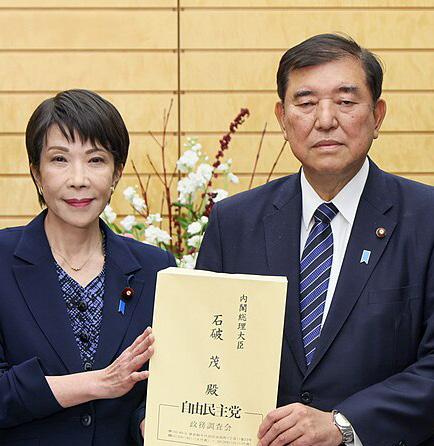
Halloween movies for people who hate horror
Penelope Cloonan Life Editor
With the spooky season in full swing, it only makes sense for the arts and entertainment section to recommend some Halloween media. Whether it runs in the background while getting ready for Halloweekend or as the centerpiece of a classic Halloween movie marathon, horror movies are essential for this time of year. But what if you’re, perhaps, a chicken? You’re in luck, so am I! Here are some of the best Halloween or horror-adjacent movies that will get you into the spirit of the season while skipping any blood-curdling fear.

The Corpse Bride (2005)
If you’re looking for a spooky, slightly off-putting movie with a little bit of romance, look no further than “The Corpse Bride.” The movie starts with love, opening with an admittedly well-matched, arranged couple, Victor (Johnny Depp) and Victoria (Emily Watson) just before their wedding day. In his nervous state, Victor stumbles into the woods. Here, he meets and accidentally marries Emily (Helena Bonham Carter), the titular Corpse Bride. Victor and Emily journey through the underworld, with Victor searching for a way back to Victoria and Emily searching for a loving marriage and her murderer. “The Corpse Bride” remains solemn throughout, but ends on a memorable, bittersweet note. The film also remains beautiful despite regularly having characters in active decay. The slightly chilling atmosphere, supported by a fantastic score by Danny Elfman, provides just enough creepiness to kick off Halloween. Though most Tim Burton or Henry Selick stop motion movies will fulfil your cravings, “The Corpse Bride” is a personal favorite.
The Addams Family (1991) & Addams Family Values (1993)
What is Halloween if not creepy, kooky, mysterious and spooky? Serving as the antithesis to the nuclear family, poking fun and commenting on the oppressiveness of the dynamic, the Addams family is an American institution. Bring a little social commentary into your Halloween line-up. If you want a touching, but ultimately odd, story about the strength of familial bonds, be sure to watch “The Addams Family.” If you want more of this message, but also fear normality—or worse, pastels—check out “Addams Family Values.” The Addams family keep up the gothic, Halloween energy all year round, so what better series to watch during the spooky season?
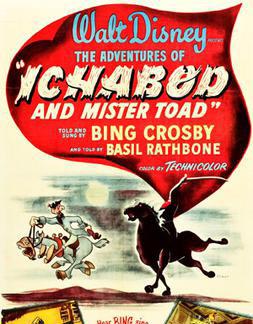
The Fear Street Trilogy
The Adventures of Ichabod and Mr. Toad (1949)
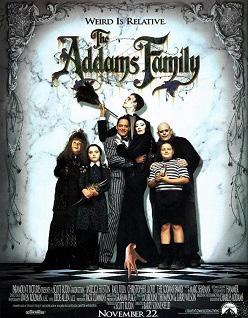
What better way to get into a spooky spirit than to revisit a classic tale? “The Adventures of Ichabod and Mr. Toad” is a double feature you can’t miss. Though “The Wind in the Willows,” involving Mr. Toad (Eric Blore), is plenty spooky, “The Legend of Sleepy Hollow,” following Ichabod Crane (Pinto Colvig, Bing Crosby), is a real cornerstone of Halloween media. This short segment is an adaptation of the short story of the same name by Washington Irving. Set in 1790 Tarrytown, New York, the audience follows Ichabod Crane—noted ditzy school teacher—on Halloween night as he parties, encounters the Headless Horseman (Billy Bletcher) and ultimately disappears. A cautionary tale suited for all ages, this is a solid family movie worth adding to your Halloween movie rotation.
If you can handle gore, but perhaps not any psychological horror, the “Fear Street” trilogy might be the series for you. Netflix’s entry into the teen slasher canon includes “Fear Street: 1994,” “Fear Street: 1978” and “Fear Street: 1666.” It all builds to one central mystery: Why are teenagers being murdered and what does it have to do with the witch, Sarah Fier? Drawing on 90s slasher films and horror royalty such as “Friday the 13th,” “I Know What You Did Last Summer” and “Scream,” “Fear Street” is a shining example of horror-lite. The series is a nice taster for horror, though it won’t leave you with any sleepless nights. It has it all: fraught romance, semi-historically accurate mystery, tests of bonds, found family and, of course, blood and guts. While it may be a stretch to call it a horror movie (spoiler alert: a girl gets her head pushed through a meat grinder), this is a gory thriller that can get you in the spirit of the season. Maybe skip the sequel “Fear Street: Prom Queen,” it simply cannot stand with its predecessors.

The VelociPastor (2017)

This movie is a truly ridiculous horror-comedy. Following the death of his parents, a priest (Gregory James Cohan), goes on a journey of self discovery in China, which ultimately leaves him with the ability to turn into a velociraptor. After the support of a sex worker (Alyssa Kempinski), he comes to terms with his new power and uses it to fight crime. With a were-velociraptor, in all honesty, what more do you need? If you need more VelociPastor in your life, fear not, “The VelociPastor 2” is officially in production. I, for one, cannot wait to see how the thrilling adventures continue.
Of course, there’s always the option of turning to paranormal shows: “Interview with the Vampire” (2022), “Buffy the Vampire Slayer” (1997), “Teen Wolf” (2011), “What We Do in the Shadows” (2019) or even “Supernatural” (2005). Given network television’s delicate sensibilities, these tend to be fairly light on true horror. Even if you’re too cowardly to watch a real horror movie on Halloween, I hope you do something to get into the spooky spirit. Happy Halloween!
I’ve got a sneaky feeling you’ll find that “Love Actually” is a horror movie
Halle Browning Contributing Writer
As Halloween approaches, the debates about which horror movie is the best are reignited; die-hard fans proclaim their allegiance to “The Shining” or “Get Out” and are willing to oppose anyone who disagrees with them. This author believes, however, that in discussions of horror films a classic has been too often forgotten, overlooked and just plain unknown. Which movie, you ask? None other than the 2003 Richard Curtis Christmas rom-com, or rather, horror movie, “Love Actually.” Told through various perspectives, the story begins by introducing you to the eight couples (if that word can even be used) that are, presumably, going to discover that love actually is all around over the course of the film. In this way, it lulls you into a false sense of calm before shaking you in a way “Barbarian” could only dream of. In an effort to keep this description from being too frightening for The Observer to publish, I’ll just touch on two of the more nightmare-inducing plotlines, both more terrifying than the other.
Disclaimer from the author: I am generally quite a rational and genial person; I don’t get road rage; I forgive people who have wronged me and believe very few people are truly unredeemable. That being said, “Love Actually” invokes a rage in me the likes of which have not been seen since Sodom and Gomorrah.
Colin (Kris Marshall)
Have you ever wondered what it would be like to live in the mind of a Reddit-fueled, un-showered, basic-human-empathy-lacking incel? Look no further than Colin’s storyline. Colin is a young 20-something man that is every bad first date combined. Upon being unable to find love in England (see reasons above), he travels to America where, just minutes after touching down, he is approached by three of the most drop-dead gorgeous women you have ever seen in your life (Elisha Cuthbert, January Jones and Ivana Milicevic). These women immediately offer him a foursome. His tale is resolved not by him growing as a person, learning to respect women or just generally becoming less of a douche, but rather by him finding another stunningly

Courtesy of IMDb
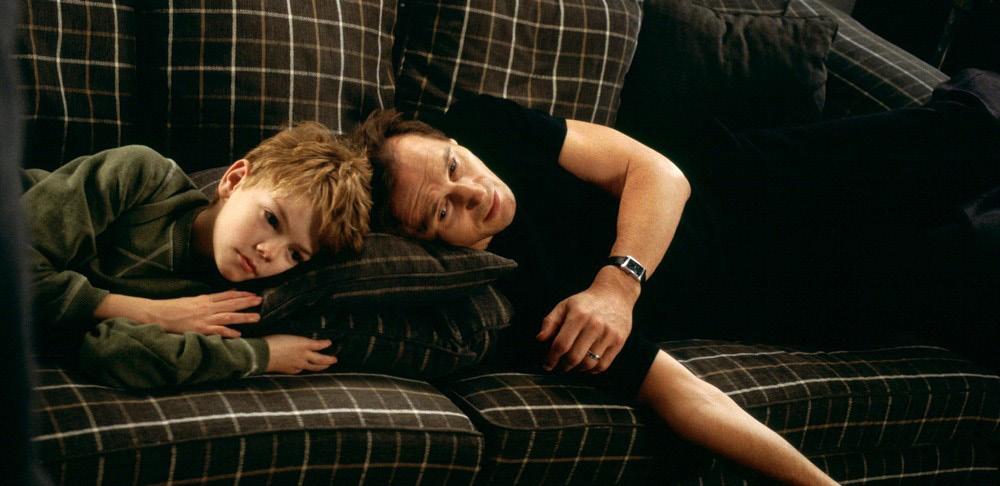
It may not seem like one at a glance, but "Love Actually" may very well be considered a horror movie for how freaky it is.
Courtesy of IMDb
beautiful American woman (Shannon Elizabeth) to bring back to the UK, because of course the foursome girls weren’t really relationship material. While his character already makes a chill crawl down your spine in the way every woman has experienced in the presence of such men, what makes his plotline so scary is that Colin is not the villain. His behavior is “rewarded” with a foursome and new girlfriend, because, of course, the issue was the English women and not his personality being akin to a 13-year-old boy whose blood flow is perpetually diverted from his brain.
Karen (Emma Thompson) Karen is a stay-at-home mother of two children with her husband, the human embodiment of getting lemon juice in your eye, Harry (Alan Rickman). Harry and his uncomfortably-younger secretary Mia (Heike Makatsch) engage in an affair which culminates in a scene that is more hairraising than “Jaws”: Karen discovers her Christmas gift from Harry in his coat, a beautiful golden heart necklace. Then, on Christmas night, the family opens gifts together when Karen discovers that her present is a CD, not the golden necklace. She quickly deduces the truth, that Harry bought the necklace for another woman, and has a
Last minute Halloween costumes
heart-wrenching moment alone in her bedroom before drying her eyes and returning to her family with a happy face to witness her children’s Christmas pageant. You may be wondering what makes this one instance of cheating so bad? While it is true that lots of people cheat in movies, what makes this particular instance so putrid is that Harry is not the villain, nor is Karen allowed to grieve beyond the cinematic scene in her bedroom. Harry doesn’t have to witness her pain, her anguish, her suffering and is rewarded with her continued fidelity and love.
But what is truly horrific about “Love Actually,” what destabilizes the very foundation of life as it is known, is that someone (Director Richard Curtis) sat down and decided to write of lust, deceit and cheating and then label it love. What could have been a delightful, if trite, holiday rom-com is bastardized as a film so upsetting it would make “The Texas Chainsaw Massacre” blush. “Love Actually” is a psychological horror film of a dystopian world where women exist only as whores or madonnas, whose sole unifying characteristic is their innate desire to seduce, adore and forgive men who have done nothing to deserve it. What is so terrifying about this movie is that I’m not that sure how many men know it is fiction.
Straight from The Observer Editorial Board
Penelope Cloonan Life Editor
Riya Kulkarni Copy Editor
A crouton
If you’ve always aspired to be part of a salad or soup, choose to be a crouton. It would be preferable for the costume to not be made of bread, and if you do, avoid the pigeons! (A cardboard box is just as crouton-y and you can double as a homeless cat).
Mime
Your friend
Do you and your friend have a distinct look? Go as each other! This works especially well for people with colored hair. Grab a wig, each other’s clothes and get your “Freaky Friday” on!
Eminem and/or M&M
To be a rapper or in a wrapper? That is the question. Go as Eminem or an M&M (or both)! Eminem’s blonde buzz and chain, or perhaps a giant “M” on your chest … either way, your costume will be sweet.
Nursing student
Don’t have time to change after clinicals? Perfect, go out in your scrubs. There’s nothing better than an authentic costume, so embody yourself.
Louvre robbers
Were you in Paris Oct. 19? We don’t want to know. Dress in all black, a neon safety vest and your ethically sourced jewels and go steal some hearts—only hearts.
Fairies
“She was a fairy…” and you can be too this Halloween! With a simple costume with “personal space bubble” wings and a Pinterest worthy outfit, be a fairy!
“We Bare Bears” bears
Another costume perfect for trios, dress in primarily white, brown or black and white to embody a grizzly bear, polar bear or panda! You’ll be there with a wink and a smile and a great old time. Wherever they are, there will be fun to be found!
Chipettes
Grab two of your friends and dress up as a chipmunk pop trio! Aim for primarily pink, purple and green outfits, add ears of some form, draw on a chipmunk nose, and you’re set! Should you need another trio, there’s always Alvin and the Chipmunks, but they’re not the real stars here.
The Very Hungry Caterpillar
Need a large group costume? Channel all of your inner child’s hopes and dreams and embody the Very Hungry Caterpillar and his week-long feast. You’ll be sure to eat in this costume!
Neo from “The Matrix”
If you feel an overwhelming sense of déjà vu, or feel as though you are living in a simulation, take the red pill and be Neo from “The Matrix.” Sunglasses, a long, black trench coat and no spoons!
Doctor
Are you pre-med? No? Good. Don the lab coat and prop stethoscope to be what your parents always wanted you to be.
A black cat
Very simple, but just as iconic. Dress in all black, throw on some eyeliner whiskers and get a cat ear headband. Be the source of someone else’s bad (or good) luck this Halloween as a black cat!
Gaslight people into thinking you’re an obscure book character
“It’s kind of niche… I don’t know if you’ve heard of it…”
Fun
VAMPIRE VODKA
Spooky maze
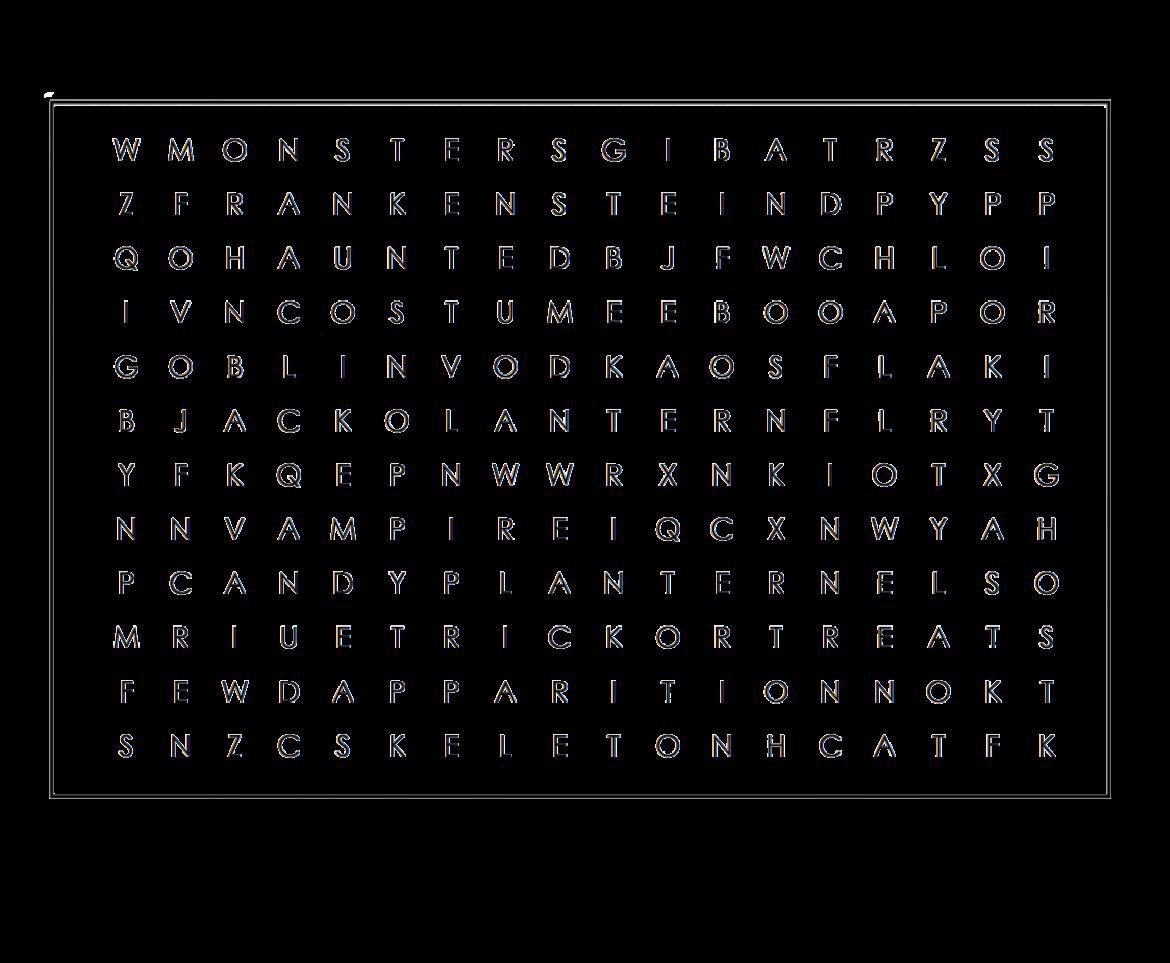
Copyright © 2025 Alance AB, https://www.mazegenerator.net/
Top 10 : EDitorial Board Halloween Experiences
Attend a journalism conference in New Orleans.
Go to a Halloween carnival with your family, but then your mom forgets she took you and goes home with your brothers, leaving you alone at the carnival. You try asking the carnies for help, and they think it would be funny if they told you your mom sold you to them and you now have to join them in their travelling carnival tour of America. In a fit of outrage and despair, you write an impassioned letter to your family expressing your disdain for joining the carnival, which is now framed in your living room and was read aloud every Halloween to follow. (Your mom came back for you an hour later.)
Black out while dressed as Chewbacca and start beating every person you pass with your lightsaber.
A guy shows up at your house wearing a lanyard from your school so you ask him his name and what grade he’s in, and even go so far as to comment that it’s crazy you’ve never met. The next morning, you turn to your left in class and realize you’ve been sitting next to him for the last four months.
You’re dressed as Velma (slutty) and you look across the street and there’s another Velma (not slutty) You scream at each other from across the street, but deep down you do some reflection on the dichotomy of man.
Lose your CaseID at a party and, instead of emailing you, the fraternity posts your ID on their Instagram story and tags you.
Lose your left shoe (for the third time that semester) at an undetermined point in your evening, only to find it three months later in a bush on the quad.
See your ex hooking up with your friend who is dressed in the same costume as you.
Spend weeks hand making a goldfish costume, only for no one to get what you are so you have to spend the rest of the eve- ning explaining what you are.
Get jump-scared while standing next to a hill, causing you to roll down the hill and break your ankle.
SPOOKY DRAW



Spooky Scary Horoscope

ACROSS:
1 Freshener to take before a job interview
5 In the beginning, God created heavens and the earth...
9 How Dracula might derogatorily refer to someone as promiscuous
12 How zombies enjoyed your brain, for one
13 Exclamation to make while surrounded by malevolent spir- its
15 The prefix to a wage-granting site
16 Host of the 2030 Winter Olympic Games
17 Birthplace of Malcom X
18 Australia's adversary in a 1932 war.
20 To repel an invading army
21 You might see a list of these at the beginning of a quarterly presentation
22 Kim _____, Hitchcock blonde of Vertigo
24 Carrie's only friend before her untimely demise
25 Peter Pan's nemesis
27 A way one might refer to a 90s British pop supergroup
31 Represented with an apple
32 Celestial event that might seem like a birth
33 Last-minute Halloween costume stop
35To assess the qualifications of a job candidate
36 ___ the line
37 He just celebrated his 14th birthday!
39 Catch a few of these for a great complexion
41 Classical form of Japanese dance-drama
43 What dots the Hollywood Walk of Fame
44 Cher's protege in Clueless
47 Your favorite Thursday night hangout spot, by acronym
Monster Match: A Worst-case scenario in Sex & dating
Auden Koetters Director of Digital Media
48 Regular hangout place
49 Opium ingredient
50 Where to look for lost things, along with crannies
DOWN
2 Where one might find Frankenstein and Nightwing on the 31st of October
3 Euclid's street categorization
4 ____ Lee, a cozy spot near campus to see a movie
5 Rude way to end text flirtations
6 Real world location to see an oasis
7 Nagging sensation
8 ____ Yildiz, the first belly dancer in the Ottomon-controlled Topkapı Palace
10 Kayak manufacturer
11 Straight-edged, Chicago-born WWE star
14 Where to go high-end shopping in New York City
18 Pacific ____, to get sushi and udon
19 Two of these combine to name this Prada subsidiary
22 Copyright-compliant Count Dracula spinoff
23 Artery counterpart
26 Postmortem dedication, in brief
28 A name to call the oracles in Macbeth, or the protagonists of Hocus Pocus
29 Biblical mother
30 High school senior's test
31 Children's playground sta- ple, with saw
33 Pick three to divine futures
34 Type of water-cooler chat
38 How to characterize a guy who just won't take a hint
40 Where one might tell spooky stories
42 Pre-summer break adieu
45 Raggedy sister of Andy
46 First female figure skater to land the triple axel
The last day of October has long been the undisputed best day of the year for two crucial reasons: one, you get to have tons of spooky fun, and two, you don’t have to buy gifts for anyone. Truly, it is the Cadillac of holidays. One of the scariest things about Halloween is the anonymity of it all. In the immortal words of Lindsay Lohan: “Halloween is the one night a year when a girl can dress like a total slut, and no other girls can say anything about it.” Lohan got it right—you can dress up as anything you want, and no one will judge you or even really know who you are. Unfortunately, however, this is a double edged sword. You can be anything you want, but so can anyone else. So, for my single and ready to mingle readers, make sure you know who you’re mingling with. If not, you can get yourself into some VERY precarious situations.
Picture this. You’re at Power Tower, and you’ve consumed the perfect amount of “liquid courage” to make everyone actually look … good? Across the room: a mysterious figure in a mask. The vibes? Unholy, but in a good way. You make eye contact (you think? Again, mask). You start to understand why they call it a Power Tower because you can feel the electricity. You don’t ask for a name and you don’t need to. It’s Halloween. Nothing’s real.
Fast-forward. You wake up. Your mouth tastes like off-brand skittles and regret. Fake blood covers your sheets. You roll over and there they are. Unmasked. And, for the first time, you see them through sober eyes.
It’s your TA.
Not just a TA—YOUR TA. The one who just took ten points off your lab report for having the incorrect number of significant figures. The one who said “interesting approach” to your ChatGPT error propagation. You both freeze.
They clear their throat. “So… about that extra credit?”
You laugh. It's not funny. Somewhere in the distance, you feel a YikYak post being born. You stare at the ceiling, your soul leaving your body like it’s withdrawing from the course in SIS. So, what can you do in this Worst Case Scenario? Well, you have two options. You can either take control of the situation or find a method of escape.
1. Why suffer when you can strategize? Take your pick from any of these enticing options.
a) Say “So… I’ll ace the final for my hard work, right?”
b) Finesse your GPA. Turn towards them and whisper seductively, “How much is participation worth again?”
c) Pull out your phone and start going through the corrections on your latest lab report.
d) Start the most cursed, but beneficial, situationship of your life.
2. In all honesty, we’re probably all too socially awkward to properly respond to such a drastic occurrence. Thus, it’s probably in your best interest to quickly avoid the situation.
a) Drop the class, major and, honestly, just withdraw from the university while you're at it.
b)Hire an Etsy witch to place a hex on them so they forget the events of the evening.
c) Gaslight them into thinking you’re your lab partner.
While The Observer does NOT advocate or support such behaviour in any way, shape or form, it is our duty as student journalists to prepare our readership for the very worst of the Worst Case Scenarios. With any of these responses you’re guaranteed a seamless response to this series of unfortunate events. With that, we wish you the happiest and safest of Halloweens!
In a world of periods, be a semicolon
Bhargavi Vatte Contributing Writer
If you ever text me, it quickly becomes apparent that I always use proper grammar. Despite arguments that my texting habits may prove to be inefficient, I find a certain level of pride in staying consistent with practices I have employed since elementary school. In fact, it is through these principles that I have deepened my appreciation for grammar—the structural order, the explicit rules and, most interestingly, the parallel of these elements to modern day society.
According to the Paris Review, the semicolon was first invented in the late 1440’s in Venice by an Italian printer by the name of Aldus Manutius. Manutius’ intended purpose for the semicolon was to allow readers to pause in order to understand more complex sentences. Personally, I strive to embody the elements of the semi-colon in everything I do. Aside from how fun it is to physically write out, the cool icons it can produce, [ ; ) ], and its historical value, the semicolon serves as a reminder to actively attempt to listen to opposing arguments and find an avenue for common ground to bridge gaps amongst differing opinions.
Observing current exchanges of discussion, I have noticed the extreme extent to which polarization has infiltrated human conversation. If an individual simply states a political ideology to which their ideas most comply with, it is automatically assumed that that individual is a “poster child” for the stereotype that comes with that political party. Automatic prejudice is instilled, prompting others to assumptively define all of the individual’s views based on a singular statement or belief. We, myself included, put a full stop to listening to other individuals completely, failing to seri-
ously consider their points of view, simply because we assume we already know everything the individual has to say or because we disagree with their stance on a certain issue. This is what I would like to call “embodying the principles of the period.”
As most of us were taught in grade school, the function of a period is to end a sentence; it is a declaratory measure to indicate that a train of thought has concluded, and a new idea will be introduced. I find that we do this to each other in our conversations—as soon as someone declares their stance on complex issues that are wrongfully painted as “this or that” issues, we paint them as being incorrect, sometimes even unconsciously degrading their value as a human in our minds. Yet, by that merit, are they not doing the exact same thing to you?
I am by no means saying that the point of conversation is for all of us to agree with one another. Convergence to a single train of thought across society is far from anything that would help us advance. Instead I am stating that the value of conversation has heavily decreased because we are unable to successfully exchange ideas. These are complicated issues that we are facing. If they weren’t—if they were truly black and white—then we may have reached a solution by now. But, that in itself is the point. A majority of people do not blindly believe their convictions, there are elements of logic and specific pieces of evidence that underlie what they stand for, just as there are influences that shape your beliefs. There are reasons these dilemmas present immense gray areas and, in turn, areas for discussion. Manutius’ intended purpose for inventing the semicolon was to allow us a second to reflect and tackle complicated topics. I believe we need to improve our exchange of ideas and decrease the growing levels of polarization
present in modern day society.
On certain occasions, we may have more in common than we thought. We may grow in our perspective or greatly influence another individual’s. In other situations, we may have absolutely no common ground in our worldviews. That is the reality that we face. I have been in situations in which after I listened to someone’s argument, I became more firm in my initial beliefs. Yet, it was after I listened. The connection between humans can be strengthened by the fact that they
took time to listen to each other in a civilized manner; they made an attempt to better understand each other’s points of view. While that may not be the solution to this toxic era of political discourse that has emerged—it is a start.
So, I encourage you to be a semicolon amongst the sea of periods. Engage in meaningful discourse to build a basis for commonality with those who you may not agree with. Who knows, maybe soon you will join me in texting with proper grammar as well.
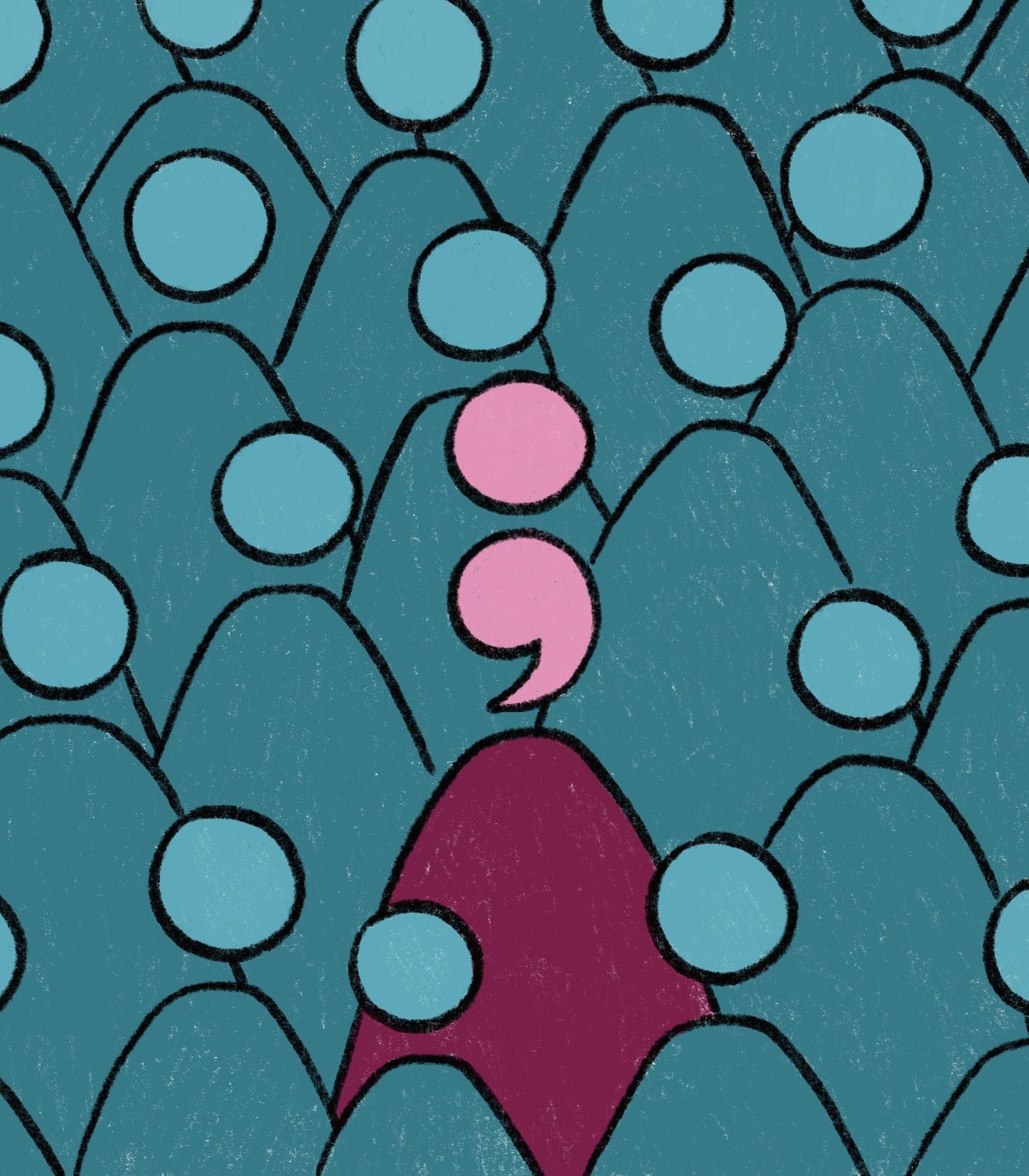
Benefits of the college sports system
Catherine Choi Staff Writer
In the United States, it is not uncommon for prospective athletes to get scouted by a college team recruiter during a game or match on the field. It is up to the athlete to decide if they will “go pro” or pursue a non-athletic career through their bachelor’s degree. On the other hand, in Europe, children that hope to be soccer players either get recruited by a youth coach of a professional soccer team or audition to get accepted to an academy. Accepted members are coached and trained to either get called up to the first team and start their professional career or transfer to a different team where they are more likely to get more minutes alongside attending school. Those pursuing solo sports might get assistance from coaches from private institutions or strive to appear in as many competitions as they can. Although all systems have their pros and cons, there are many benefits
to the current college student athlete system that is used in the United States.
Primarily, it reduces the physical and mental burdens placed on young athletes. Many athletes start training at an early age, as building skills takes long-term and consistent effort. In alternative systems, children aged 6-12 years old are navigating the entire professional journey on their own by having to train enough to be at the pro-level. They gather financial support and coaching resources, make appearances at competitions and, in the case of team sports, search for teams and sign contracts. As a result, they are more likely to be overwhelmed and suffer from high pressure, burn out and spend too much of their time training and practicing. Even worse, children are more susceptible to abuse from parents and coaches than adults and may be left with life-long trauma, such as excessive perfectionism or low self-worth. Despite certain benefits, such as allowing them to start their career at a young age, the cost
oftentimes outweighs the benefit because it puts pressure on the athletes to compete with others their entire lives, deal with spotlight and criticism and struggle to stay disciplined due to the fame and prosperity when they are too young to handle it. It puts a lot of the burden on the parents as well, as it is their responsibility to find good resources and coaching, provide financial support and assistance. The current college athlete system postpones the pressure to take the profession seriously. While students are participating in team sports at the high school level, they are able to gain experience with dedication and commitment, navigate through strenuous training and take ownership of their academic performance to establish a balance. High school athletes are able to improve and enjoy their performance in sports because much of their motivation is intrinsic.
Secondarily, it promotes exercise in everyday life and fosters more opportunities. In the current college admissions system, where
one’s athletic abilities are as appreciated as their academic ability, people are more motivated to participate in sports, which can provide an outlet of decompression from the stresses of academics. Even if they do not pursue a career or get athletic scholarships, exercise is strongly encouraged for its diverse benefits, such as reduced risk of mental health disorders, better academic performance, prevention of severe illnesses and building a healthy physique. It also helps young students build important skills such as teamwork, discipline and leadership that are necessary for future career pathways. With colleges acknowledging their applicant’s skill in sports and providing athletic scholarships, more students are open to the opportunity for higher education and athletic success. The benefit extends beyond college admissions.
Continue reading on page 10
College sports system from page 9
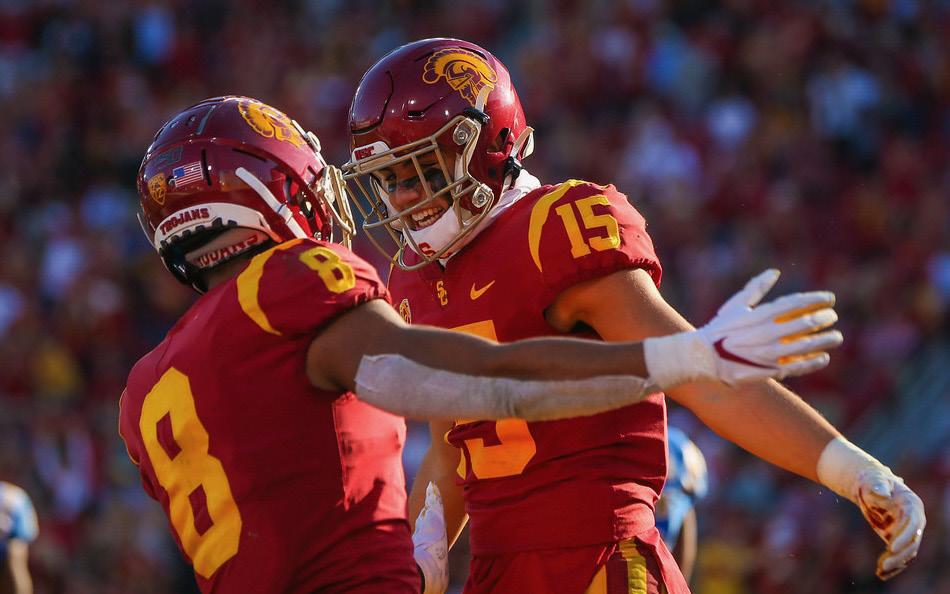
Courtesy of Steve Cheng via Creative Commons
Although the best case scenario is where all student athletes achieve their career aspirations, there are unforeseen circumstances where it may not be possible, such as delayed progress, failure to survive the competition or injuries. In this case, athletes will be forced to look for alternate career pathways. By not having their beloved sport to come back to, finding motivation for recovery and re-assimilating into social environments may become more difficult and discouraging. Because both high school and college sports teams require students to demonstrate certain levels of academic accomplishment, students are more likely to pay attention to academic progress as well. During the process, they are exposed to people
with various backgrounds, career aspirations and lifestyles instead of isolating themselves or only associating with teammates and coaches. As a result, they are able to have a more comprehensive outlook on life and be more adept to society.
Of course, college sports are still criticized as they can put too much pressure on students to handle numerous responsibilities. However, they can also foster an atmosphere where students are evaluated based on academic accomplishments, providing resources for their career without putting too much pressure on the young athlete. In this way, students can be prepared for unforeseen circumstances in which they cannot continue their athletic career.
Home is not finite, and it’s not just in a house
Riya Kulkarni Copy Editor
Many of us decided to go home during fall break, which meant that many of us had to leave home to come back to campus once fall break came to a close. For many, it’s a bittersweet feeling knowing that the parting is temporary. While we may be excited to return to our college friends, it can be sad to leave our familiar home behind. Others may just feel excited to connect with college friends and the community they have built away from home.
But beyond the home-cooked food, the reunion with the house pets and the meetings with close friends lies the overwhelming recognition of being “home.” It’s the feeling of peace that comes with being in a place full of memories.
It’s that feeling and comfort that defines a “home,” beyond any concrete, four walled structure, and we continue to build it wherever we go.
It’s the spirit of home that we search for in the people we form relationships with. Whether it’s a friend or a life partner, we look for people who bring comfort and warmth—a familiar face that we can return to and feel connected with.
Some are still finding that home, moving from place to place. This journey is a lonely one, and it can be scary to break away from what is known and certain. They begin their next chapter on their own, setting up artifacts to make their new house more personal. But soon, that same cold room can glow bright with the laughter of friends, and the walls turn vibrant colors after countless stories and late night conversations. It is with the people we find that we begin to build memories of our own to look back on, golden moments that motivate us to keep moving forward.
These feelings can last, even when it’s time to pack up our bags and continue life’s journey. We take what we’ve learned with us and move on to somewhere new, still remaining connected with what we left behind. This leads us to form more connections everywhere we go—the cycle repeats.
This can mean that for some people, home is in multiple places. Whether it is where family lives or where friends are found, a little bit of home rests with them. These different homes could be close to-

gether and easy to travel to, but for many they are far apart. Part of us gets left with each home as we journey on to the next.
And maybe that means that home is not finite, that it’s grown and cultured everywhere we go. In each place we pour a little home into the earth we stand on, leaving our mark in some form. No matter how many people we meet or how many places we go, there’s always some amount of home left for us to pour someplace else.
At the same time, we collect the homes of the people around us, people who entrust us to hold a bit of theirs for the rest of our lives. We learn from them and grow with them in the time we have together
and, when it’s time to part ways, we take their lessons with us as we move on to the next chapter.
Not only does this mean that home is something that we find everywhere we go, but home is also something that we constantly work to build. It’s a culmination of our memories and experiences and all that we find familiar, supported by the people we met along the way to make these experiences as familiar as they are. It’s an idea of tranquility we set for ourselves so we can one day relax within its metaphorical soft walls and enjoy the world we’ve built around us, our safe space. We try our hardest to make it as happy as possible.
That’s the meaningful part as
we go through our lives and build our own homes: our home is something that is constantly changing. It grows with us as we progress from chapter to chapter, and the more we experience, the more we feel home all around us. It will grow and change just as we do.
So, as we sit in the home we build now at this university, we can reminisce about the memories that rest like photos on the walls and stories of our experiences that pile on the shelf. Of course, our home has plenty of empty space for all the memories that are to come. We can lean back and relax in front of the (school-sanctioned) fireplace, sipping a cup of hot chocolate, ready to bear the cold of the winter ahead.

Sahar Kapasi/The Observer
LTTE: Upon whose shoulders we stand
Thomas Kim Hill Contributing Writer
In recent months, we have lost several members of our Case Western Reserve University community. As we who work for peace with justice, know we stand on the shoulders of those who came before us.
I would like to remember Bennie Khoapa, Nahida Gordon, Douglas Kerr and Don Freeman, each of whom was singleminded in their life-long quest for truth, justice and peace. It is no accident that we often chant in the streets the old Biblically-rooted adage, “No Truth, No Justice, No Peace.” On the other side are those who worship at the temple of Mammon where “It is all about the Benjamins,” in the classic words of the U.S. Representative Ilhan Omar. I offer below four brief sketches of four remarkable lives. I cannot possibly credit all of their accomplishments, but I hope to keep each of them alive in our memory.
Bennie Khoapa earned a PhD at the Jack, Joseph and Morton Mandel School of Applied Social Sciences at CWRU in the area of social welfare. He, himself, was a political refugee from South Africa, where his colleague, Steve Biko was murdered by the South African apartheid police. Biko is the subject of the film, “Cry Freedom,” about resistance to apartheid after Nelson Mandela was imprisoned. Leaders of the African National Congress (ANC), Mandela’s congress, were all in prison, in exile or killed when Biko led a new youth movement for “black consciousness.” Like Biko, Bennie was confined for five years under house arrest. Bennie escaped to the U.S., got his degree and went on to teach sociology in Michigan. When the apartheid government fell, he returned home to teach at Durban University of Technology, where he directed the annual celebration honoring Biko.
Nahida Halaby Gordon taught bio-statistics at CWRU’s Frances Payne Bolton School of Nursing. She was one of the Palestinians driven from their homes by Jewish militias in the 1948 Palestinian Nakba (catastrophe in Arabic). 750,000 Palestinians, with their descendants, became permanent refugees in their own homeland, up until today. Nahida co-founded the Interfaith Committee for Peace in the Middle East along with other ‘48 Palestinians. It brings together Muslims, Jews, Christians and others in prayer and service to the cause of peace. Nahida shared a Cleveland Peace Action event with Abbas Hamideh of Al-Awda, standing for Palestinian Right of Return Coalition. Later in life she traveled to Jaffa in Israel to visit her father’s house (a polite Jewish owner allowed her to come inside to rekindle childhood memories).
She published her book, “Palestine Is Our Home” in 2016.
Douglas Kerr was a physician and researcher at CWRU and University Hospitals in pediatrics. He was born in Beirut, Lebanon in World War II and lived in several countries in the region before moving to the U.S. His brother, Malcolm Kerr, was a scholar of the Arab world and was chosen to become president of the American University of Beirut in the tumultuous 1980s, where he was assassinated in 1984. Doug dedicated himself to peace, and was on the national board of Churches for Middle East Peace, which sends delegations of Americans to visit and learn about the Israel/Palestine (I/P) conflict. He teamed up with his wife, Mary Ann Kerr, in Cleveland to sponsor such trips. Theologians who witnessed Israeli apartheid firsthand often returned home to support boycott, divestment and sanctions in their own churches.
Doug was a leader in Cleveland Peace Action where he helped sponsor programs on Middle East peace-making. One guest was Iyad Burnat on the film “5 Broken Cameras.” Doug co-authored an important op-ed with CWRU professor Ted Steinberg in 2016 analyzing the I/P peace process.
Don Freeman attended Cleveland Public Schools in the 1950s and then CWRU as a scholarship student. He returned to teach at the secondary level in Cleveland. He was fired by Superintendent Paul Briggs, in collaboration with the Federal Bureau of Investigation, for working with and hosting Malcolm X in Cleveland. For years Don and his wife, Norma Freeman, attended and monitored meetings of the Cleveland Board of Education, documenting the failures that led the federal judge Frank Batista to order desegregation and busing to overcome deliberate patterns by the board to keep the schools segregated. Don and Norma regularly published their magazine, “Vibration,” to document this and other freedom struggles. The magazine was dedicated to “the resurrection of the mentally and spiritually dead.” Norma was proud of actually having met W.E.B. Du Bois at her historically black college in the South. Don spoke at vigils for Timothy Russell and Malissa Williams, killed by Cleveland police in East Cleveland, which he termed the 137 shots “Atrocity.” His book is entitled “Reflections of a Resolute Radical.” It will be a tall order to fill the shoes of those who came before us at CWRU. But we can and must. Their marvelous leadership and work require us to carry on. We can keep on by supporting the students unfairly punished by CWRU’s administration for their strong stand against what is now almost universally condemned as genocide in Gaza.
The Case Western Reserve Observer
Established in 1969 by the undergraduate students of Case Western Reserve University
Darcy Chew Executive Editor & Publisher
Hannah Johnson Director of Print
Sabrina Feldberg News Editor
Alyssa Wang News Editor
Penelope Cloonan Life Editor
Aleksandra Majewski Opinion Editor
Ellie Palaian Sports Editor
Michelle Bai Copy Editor
Riya Kulkarni Copy Editor
Siya Motwani Copy Editor
We’ve all been there, trying to study or finish that last assignment when all we want to do is … anything else. Maybe we’re overwhelmed with the work we have to do, or maybe we feel the pressures of perfectionism and don’t want to start. We push ourselves to “lock in,” but call it quits too often, feeling guilty each time we pick up our phones to doomscroll again and again. Doing anything but the work we have piled up always seems to feel better than actually getting things done, but the sinking feeling in our stomach knowing we’ve wasted time is much worse. Can we really consider these pauses to be “breaks” if we feel worse after taking them?
Abhishek Nambiar Copy Editor
Mariana Parilli-Castillo Copy Editor
Lily Zhang Copy Editor
DESIGN
Anjali Bhuthpur Director of Design
Lucas Yang Director of Design
Shareen Chahal Layout Designer
Sahar Kapasi Layout Designer
Reva Kolhe Layout Designer
Elizabeth McHugh Layout Designer
Kiera Ng Layout Designer
Nithya Pandari Layout Designer
Jana Ashour Graphic Designer
Kristina Guo Graphic Designer
Sophie Shimeall Graphic Designer
Anna Trusova Graphic Designer
We may trap ourselves in a cycle of counterproductivity and double the time it takes to complete a task. In this “popcorn brain” mindset, we work and get little done, then stop working and think about how we could be working. By the time we resume our work, we feel ashamed, not refreshed, and we stay up late in attempts to catch up.
DIGITAL MEDIA
Auden Koetters Director of Digital Media
Moses Fleischman Web Editor
Ayan Sheikh Video Editor
Matthew Stall Video Editor
Obafami Tidjani Web Editor
Phillip Kornberg Photo Editor
Tyler Sun Photo Editor
A break is not shameful, not when it has the potential to act as a tool that makes productivity much more efficient. We just need to know how to use them.
Esha Bagora Social Media Editor
Benjamin Kang Social Media Editor
Timothy Le Social Media Editor
Rhea Soni Social Media Editor
Just as an athlete wouldn’t do 150 consecutive bicep curls while strength training at the gym, as students we must take meaningful breaks in reasonable intervals. One popular example of this is the Pomodoro method, where 5 minute breaks follow 25 minutes of work (10 minutes of break to 50 minutes of work is also a popular option). By time-boxing our productivity and knowing we will be rewarded,
Ethan Daley Sports Broadcaster BUSINESS
Tyler Vu Director of Business Operations
Riya Dixit Ad Manager
Divya Kurma Business Manager
Anya Lin Analytics Manager
Ria Trivedi Marketing & Distribution Manager
The Observer is the weekly undergraduate student newspaper of Case Western Reserve University. Established in 1969, The Observer reports news affecting students and provides an editorial forum for the university community. Unsigned editorials are typically written by the opinion editor but reflect the majority opinion of the senior editorial staff. Opinion columns are the views of their writers and not necessarily of The Observer staff. For advertising information, contact via e-mail at observer@case.edu. LETTERS TO THE EDITOR should be e-mailed to observer@case.edu or submitted on our website at observer.case.edu. Letters can be mailed to Thwing Center 11111 Euclid Avenue, Suite 01, Cleveland, Ohio 44106. For policy and guidelines related to the submission of Letters to the Editor, refer to observer.case.edu/submit-a-letter.
The Observer is a proud member of CWRU’s University Media Board. Follow The Observer on Facebook, Twitter, TikTok and Instagram @cwruobserver.
Sports
Spartan men’s and women’s soccer return home undefeated after four-game weekend
Darcy Crew Executive Editor
This past weekend, the Case Western Reserve University men’s and women’s soccer teams completed an undefeated doubleheader, facing UAA opponents Brandeis University and New York University with four shutouts. Following the games, the men’s team improved 1-2-2 while the women’s team improved 3-1-1.
The first games of the weekend were held in Waltham, Massachusetts against the No. 5-ranked men’s team and No. 19-ranked women’s team.
In the men’s team’s hard-fought match against the Judges, which eventually ended in a draw, fourth-year goalkeeper and co-captain Bradley Winter and second-year midfielder Ashton McNally delivered stand-
out performances. Winter set a new school-record in shutouts in a single season with nine, and recorded four saves during the game. McNally led the team in shots with a total of four shots with one on goal. Offensively, the Spartans had outshot the Judges 16-13 with 5-4 in shots on goal.
The following Sunday, the Spartan men recorded their first UAA win against the NYU Violets. The victory was complete with another set of standout performances by McNally and Winter. During the 56th minute, McNally scored the game-winning goal with an assist from fourth-year forward McLaren Baggett. Following Baggett’s chip to the middle of the box, McNally beat the Violet goalkeeper on a slide to secure the goal.
“What stood out most to me this weekend was the hard work from everyone on the team,” McNally said.
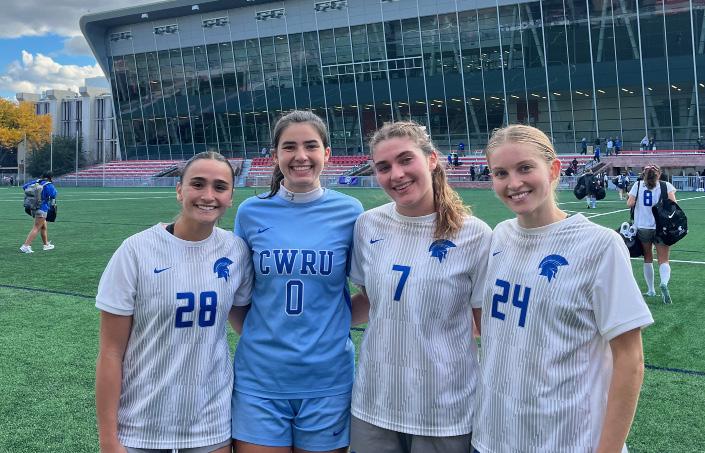
Phillip Kornberg/The Observer
“Double weekends are the hardest mentally and physically, especially on the road, but everyone on the team gave their full effort, and that was the reason for our success.”
The No. 6-ranked Spartan women dominated this weekend against No. 19-ranked Brandeis and No. 24-ranked NYU, scoring both 2-0 against their UAA opponents. With their two wins, the Spartan women are currently tied with this weekend’s opponent Emory University for second in the conference.
Despite the Judges early possession, the Spartan defense kept Brandeis off the scoreboard, blocking two cornerkicks and a shot within the first 16 minutes. The Spartans then took control of the field which culminated in a goal from first-year defender Mia Modrovich in the 21st minute with an assist from fourth-year midfielder and forward Molly Shamah. The goal marked the first of Modrovich’s career.
The Spartan’s second goal came during the second half, following first-year forward and midfielder Izzy Probst’s connecting with fourth-year forward Maggie Farra at the edge of the 6-yard box off of a throw-in.
Probst scored the first goal against NYU during the 30th minute. Secondyear midfielder Abby Welker successfully gained possession of the ball before connecting with Probst who shot the ball into the bottom corner of the net. The Spartans doubled the score after a goal from fourth-year forward and midfielder Alexis Sassower who was assisted by fourth-year midfielder and defender Julia Flynn.
“Reflecting on this weekend’s games, our team’s energy and the goals we set throughout the week were clearly reflected in how we played,”
Probst said. “One of our main focuses was to start strong and give full effort for all 90 minutes as a unified group. I think we did an excellent job of that in the Brandeis game on Friday. It was exciting to see the team’s growth and especially rewarding to watch Mia Modrovich score her first goal.”
Defensively, second-year Ellie Palaian recorded a total of six saves this weekend. Similar to Winter, Palaian set the season-program record in shutouts with 11, breaking a tie with former Spartans Maggie Storti (2021) and Anna Kennedy (2011). For their impressive defensive work in front of the net this weekend, both goalkeepers were named UAA Defensive Player of the Week and Spartan Club Athletes of the Week.
The women’s team are currently ranked third in NCAA Power Index and also increased in the United Soccer Coaches Top 25 ranking to No. 5 in the nation. All eight UAA teams are nationally ranked, making the conference a challenge and learning experience as the Spartans aim for a national championship.
“As a team, our ultimate goal this year is to win a national championship and to be the best at doing the little things right,” Probst said. “For the rest of the UAA, our focus is to win out and continue performing at our highest level.”
Both teams will be hosting Emory this weekend on DiSanto Field for the final home game of the season. Emory’s men’s team currently ranks No. 4 in the nation while the women’s team ranks No. 2. The men’s team will be celebrating their six graduating seniors before kickoff at 11 a.m. on Saturday, Nov. 1, followed by the women’s game at 1:30 p.m.
NCAA permits college athletes and staff to wager on professional sports
Ellie Palaian Sports Editor
Effective Nov. 22, 2025, all NCAA athletes and athletic department staff members will be permitted to place bets on professional sports, marking a significant policy shift from previous regulations, which prohibited all sports wagering.
This change comes as the NCAA has seen a rise in sports betting violations in recent years. For example, three basketball players from Fresno State University and San Jose State University recently had their eligibility revoked after placing bets on each other and winning thousands of dollars. Additionally, 13 Division I men’s basketball players from six schools are currently under investigation for alleged gambling violations. The NCAA believes that allowing athletes and staff to legally bet on professional sports may reduce or eliminate the incentive to engage in betting on collegiate competitions.
Following the approval of the policy change by the Division I council, Divisions II and III quickly adopted the same measure, allowing the new rule to officially take effect on Nov. 22.
“The Administrative Committee was clear in its discussion … that it remains concerned about the risks associated with all forms of sports gambling but ultimately voted to reduce restrictions
on student-athletes in this area to better align with their campus peers,” said Josh Whitman, Athletics Director at the University of Illinois and Chair of the Division I Administrative Committee. “This change allows the NCAA, the conferences, and the member schools to focus on protecting the integrity of college games while, at the same time, encouraging healthy habits for studentathletes who choose to engage in betting activities on professional sports.”
Although NCAA athletes and athletic department staff are now permitted to wager on professional sports, they remain strictly prohibited from betting on any collegiate competitions or sharing insider information related to college athletics. Student-athletes who violate these rules risk losing their eligibility and can only be reinstated with institutional support. Those who attempt to influence game outcomes or provide betting information to others may face a permanent loss of eligibility. Betting on one’s own sport, even if it does not involve their school, can result in a suspension of up to 50% of a season.
The NCAA has emphasized that this policy change is not an endorsement of gambling. Rather, the organization aims to adapt to the evolving sports landscape while encouraging responsible behavior. The intent is to reduce the incentive for athletes and staff to engage in illicit betting on college sports by providing a
legal alternative, while also promoting awareness of the risks associated with gambling.
To support this effort, the NCAA is reinforcing its existing educational programs. These include published harmreduction guidelines, a partnership with EPIC Global Solutions that has reached over 100,000 participants, a gamblingawareness e-learning course completed by more than 50,000 student-athletes worldwide and research showing that 67% of college students regularly engage in sports betting.
“Abstinence-only approaches to social challenges for college-aged individuals are often not as successful as approaches that focus on education about risks and open dialogue,” said Dr. Deena Casiero, NCAA chief medical officer. “The NCAA will continue to collaborate with schools to help them provide student-athletes with meaningful education and other resources for student-athletes who choose to participate in betting on professional sports. This harm reduction approach gives schools an opportunity to help student-athletes make educated decisions, prevent risky behavior and seek support without fear of impacting their eligibility.”
On Oct. 27, Case Western Reserve University Associate Athletic Director Pat Kennedy sent a brief email to all CWRU athletes notifying them of the new NCAA ruling. In the message, Ken-
nedy included links to NCAA educational resources and support materials referenced in the policy announcement, encouraging athletes and staff to review them.
The NCAA Division I Student-Athlete Advisory Committee (SAAC) has expressed support for the decision but emphasized the importance of providing comprehensive education and safeguards to protect the well-being and integrity of student-athletes. Although the NCAA has not yet announced any changes or additions to its current educational programs, many anticipate that institutions across the country will soon advocate for more mandatory and robust training for both athletes and coaches in response to this ruling.
“We believe this change represents meaningful progress toward a culture that prioritizes education, transparency and support over punishment,” the Division I SAAC executive team said in a statement. “By removing unnecessary barriers, we are hopeful that studentathletes and athletics administrators will feel empowered to come forward, seek help and engage in open dialogue without fear … We are hopeful, and expecting, that the NCAA and its membership will meet student-athletes halfway by providing the necessary education, resources and support systems to ensure well-being and integrity remain at the core of college athletics.”
Scores
Men’s Soccer
Senior Spotlights: The final chapter for CWRU’s men’s soccer’s graduating class Weekly
at Brandeis (10/24) T 0-0 at NYU (10/25) W 1-0
Women’s Soccer
at Brandeis (10/24) W 2-0 at NYU (10/25) W 2-0
Football at Thiel College (10/25) W 55-7
Volleyball
UAA Round Robin #3 vs NYU (10/12) W 3-2 at UChicago (10/26) L 1-3
Swim and Dive Battle in the Bluegrass at Centre (10/25)
Abhishek Nambiar Copy Editor
Men’s Team W 385.0-69.0
Women’s Team W 297.0-180.0 at Ohio Wesleyan Centre (10/25) Men’s Team W 172-70
Women’s Team W 157-116
Upcoming Games
Men’s Soccer vs Emory 11/1, 11 a.m., DiSanto Field, Senior Day
Women’s Soccer
vs Emory 11/1, 1:30 p.m., DiSanto Field
Football at Thiel 10/25
Volleyball
vs Otterbein 11/1, 3 p.m., Horsburgh Gymnasium, Senior Day
Swim and Dive
vs Carnegie Mellon 11/1, 10 a.m. Diving; 1 p.m. Swimming, Veale Natatorium vs Franklin (10/25)
Cross Country
UAA Championships 11/1
All photos by Phillip Kornberg/The Observer
Nov. 1 marks this year’s Senior Day for the Case Western Reserve University men’s soccer team. On this day, the -

team. Through their various highs and lows over the past four years, they have persevered while continuing to look out for and support each other.
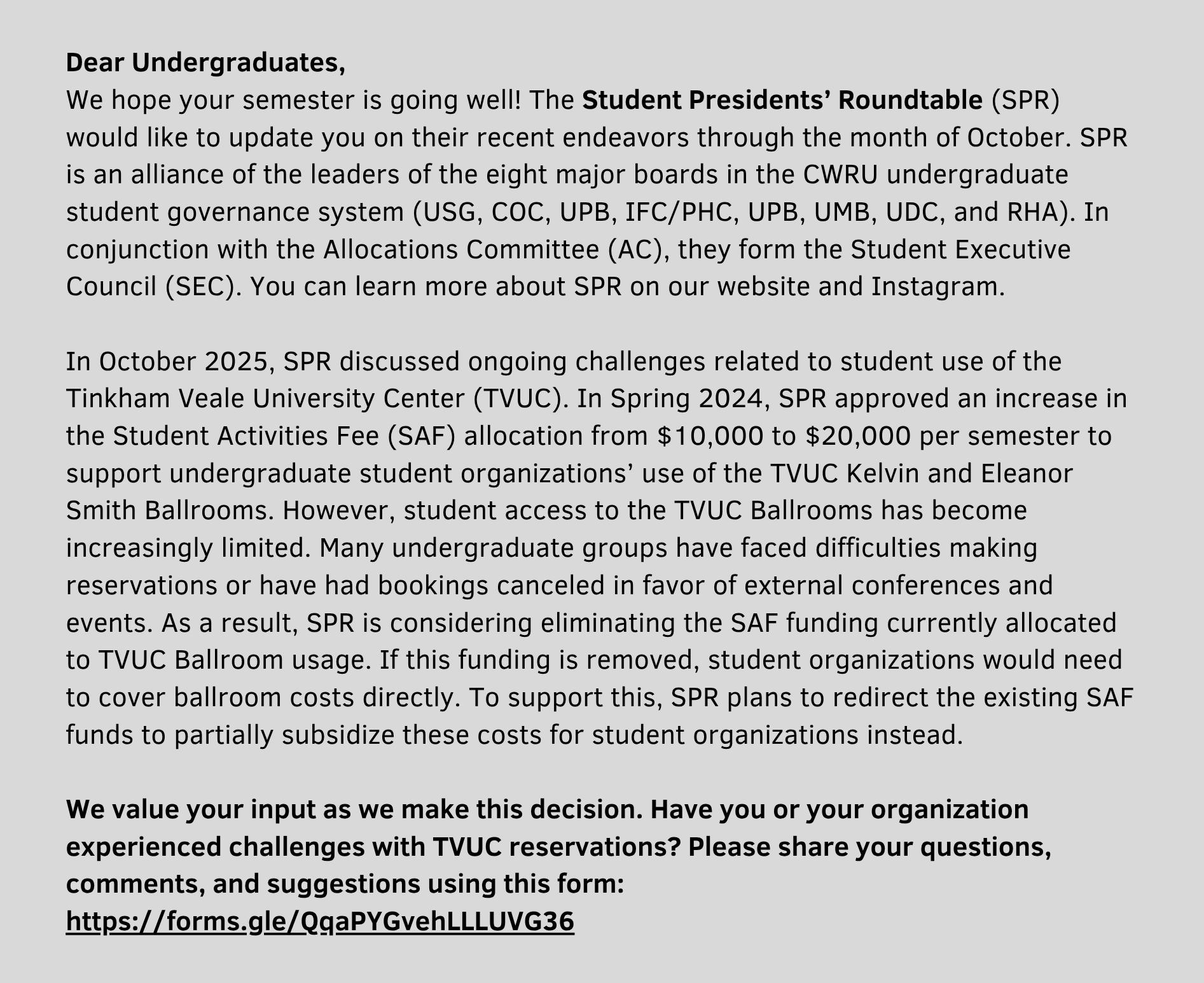
Senior Spotlights from page 13
Fourth-year midfielder Camden Larson has made his mark as a Spartan. This past year he was named to the CSC Academic All-District team. Having played in 64 games for the Spartans, totaling over 4,400 minutes on the field and starting games for CWRU all four years, he has certainly been a crucial member of the team for his entire tenure.
Like many of his teammates, Larson’s recruiting process was not the smoothest. Initially targeting high-academic programs across the Northeast and Midwest, Larson sought a school that would challenge him both intellectually and athletically. After attending an ID camp at CWRU—where an untimely illness hindered his performance—Larson might have thought the opportunity had passed. But his persistence paid off, as eventually he got an offer from Coach Poe to join the team.
“After listening to his vision for the program and seeing that Case was a good fit academically as well as a place where I could potentially have an early impact on the field, I decided to commit,” Larson said.
Larson’s consistency, leadership and work ethic have anchored a defense known for its discipline and resilience. But perhaps what stands out most is his ability to manage the dual challenges of pursuing a computer engineering degree and taking part in varsity soccer—a balance that demands precision and perseverance.
Camden Larson
“It is definitely possible, but has taken some sacrifices of social life and free time at points,” Larson admitted. “One thing that has helped me is planning ahead, especially while we are in season, to know when all of my exams and projects are coming up so I can start them early. It has also been beneficial to have close friends in my classes that are athletes as well and understand how to get things done in a time crunch.”
This drive extends beyond the field, where Larson has been involved in CWRU’s VTOL club. In this capacity he has served on the electronics team, writing software for drones as well as performing data analysis and mission modeling for the club.
Larson’s decision to pursue a computer engineering degree stems from a natural ability for math and problem solving and personal fascination with technology. After graduation he hopes to take up a job somewhere close to home in Maryland. Before then, as his senior season winds down, Larson hopes to savor every last moment on the field, reflecting on what has been an unforgettable four-year journey alongside his teammates.
“We immediately grew close during preseason freshman year, almost treating college like a sleep away camp,” he reflected. “We’re a very tight class and I can’t wait to see the journey everyone takes after graduation.”

McLaren Baggett

Fourth-year forward McLaren Baggett has been involved in soccer for as long as he can remember. Getting his start in a soccer-tots program at the age of three, the sport has been a lifelong part of who he is. As he approaches the end of his final season as a Spartan, Baggett reflects on how the game has shaped him both as an athlete and as a person.
“While it is true I’m a senior, and the end of this season will certainly be bittersweet I have no doubt, soccer is never truly going to be left behind for me,” he said. “Having played for so long, it’s a piece of the person that I am. The successes, failures, and people which the game has brought me shape the person I am today.”
Baggett’s journey to CWRU was not the typical recruiting story, as he had already gained admission to the university before Coach Poe was aware of him. What settled his decision to commit to CWRU was its reputation for strong academics, having heard good things about it from family friends who had attended the school.
“Upon being accepted I reached out to Coach Poe to see if he had a roster spot open and he thought I would be a good fit for the team, so decided to offer me the spot,” Baggett said.
Since taking up the offer, Baggett has played in 33 games, spending over 800 minutes on the field. Though he hasn’t always been among the most visible players on the field, his commitment and preparation have made him an essential part of the squad’s depth and culture. This can also be seen off the field, where as an aerospace engineering major with a business management minor Baggett found his limits being tested early on in his collegiate career.
“In all honesty, it was a struggle at
first. The workload from my major coupled with the responsibilities of a varsity athlete was a lot to handle. However, with the help of teammates and some adapting to new circumstances I learned how to budget out my time efficiently and maintain the balance between my degree and soccer,” Baggett said.
On the topic of teammates, for Baggett the most meaningful part of his time at CWRU has been the people—including the teammates he has played, studied and hung out with over the past four years.
“Words aren’t enough to describe the bond that we all share having been through these past years together,” he said. “It’s been amazing getting to spend these seasons together and watch each other grow as we’ve progressed, both in soccer and as people. The battles we fought both on the field and off will be memories to last a lifetime.”
Looking ahead, Baggett is beginning to plan for life after graduation. He hopes to join the workforce and is currently in the process of interviewing with and applying to a wide variety of startups and companies that best suit his interests. In the meantime, he hopes to close out his time on the team knowing that he made a difference that those who will still be on the team next year can take with them. He is also grateful for the strong support his teammates and coaches have provided him throughout his collegiate career and hopes to return the favor to all of them.
“I’d [like] to let all of my teammates and coaches know that the impact they’ve had on me throughout my time in the program has truly changed me for the better,” he said. “I am eternally grateful to each and every one of them.”
Senior Spotlights from page 14
Fourth-year forward and cocaptain Stephen Vilardo has played soccer for nearly his entire life, first picking up the sport when he was three years old. Over his collegiate career he has played 25 games for the Spartans, amounting to over 700 minutes of play time. While this may not be as much time on the field as some of his peers have amassed, each of those minutes has reflected his persistence, work ethic and unwavering commitment to the program.
Vilardo’s recruiting process was a very tumultuous one, but ultimately he made the choice to commit to CWRU because he wanted to play for Coach Poe and the school’s reputation for a strong pre-med program. That combination of competitive athletics and academic rigor made CWRU the ideal place for him to grow both as a player and as a student.
As a nutrition major on the premed track—a path known for being time consuming and extremely rigorous—Vilardo has found the best way to juggle all his commitments is to be smart with the time that he has.
“There’s a lot going on at all times and just taking it step by step, one task at a time, has allowed me to be successful,” he said.
His ability to juggle training, travel and academics speaks to the discipline that defines him as both an
Stephen Vilardo
athlete and a student.
Beyond the pitch, Vilardo is involved with the CWRU chapter of Camp Kesem, a national nonprofit organization supporting children affected by a parent’s cancer through free summer camps run by college students. Upon his graduation in the spring, he plans to attend medical school on his way to becoming a physician.
“I love to talk with people and show that I am someone who wants to help them get through tough times,” he said in regards to why he chose his major and pathway. “I’ve also grown a huge appreciation for the intricacies and subtle perfections that make the human body function.”
As a reflection of his traits, Vilardo was chosen by his teammates to serve as a team captain for the season. Vilardo himself describes it as “a huge honor given to me by my teammates.”
“While it has come with its challenges, it has helped me grow immensely as a leader and form what kind of person I want to be,” he said.
As Vilardo enters the final weeks of his collegiate career, he notes how surreal it is to be so close to the end while giving the sport his all before he plays his final collegiate match.
“I want to leave the sport knowing I gave my best effort every second I was with the team. I hope the bonds I have formed on the field persist off of it,” he said.
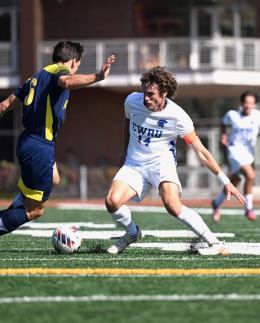
Phillip Washington
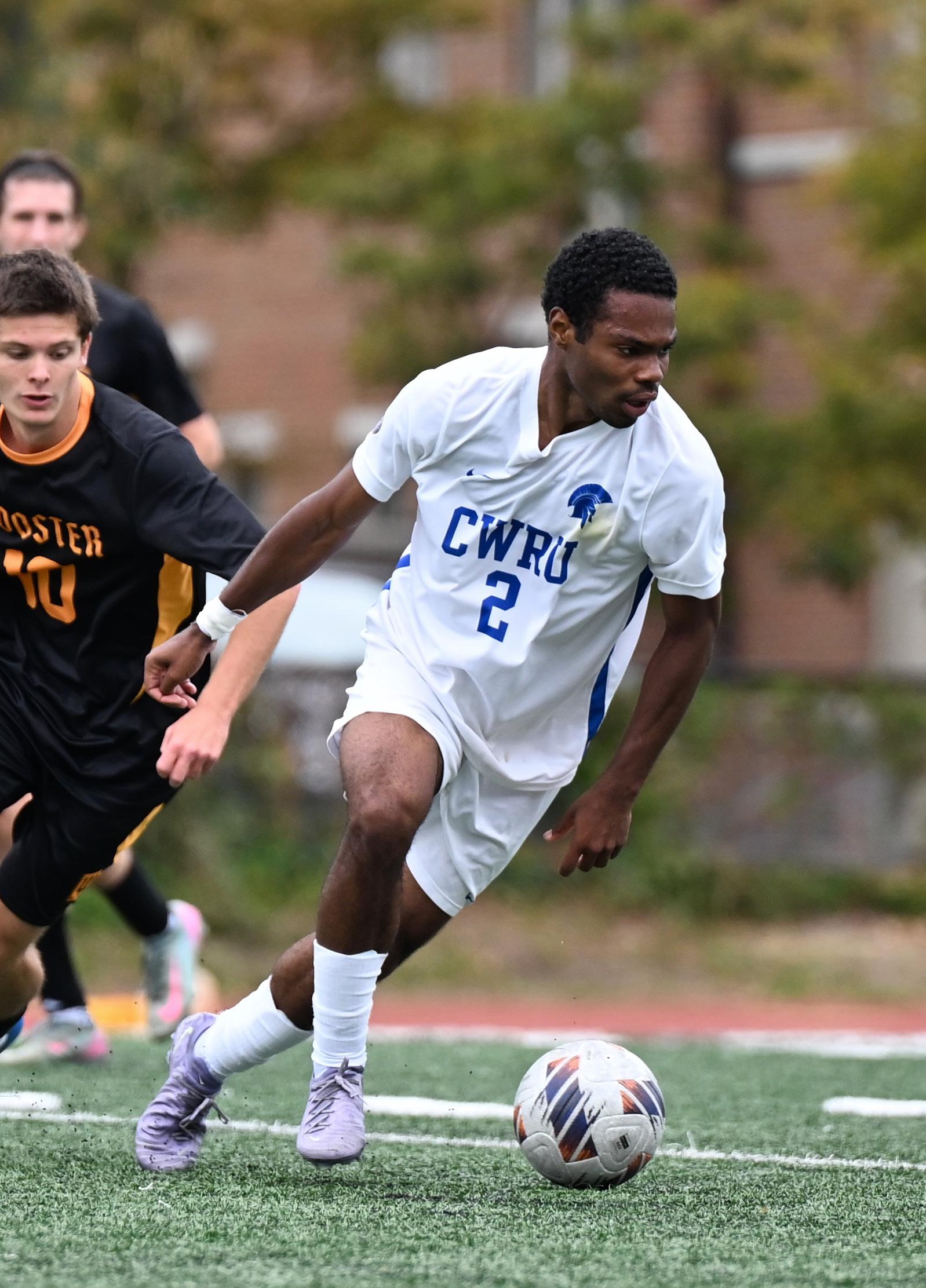
Fourth-year defender Phillip Washington’s first visit to CWRU came during the middle of a snowstorm. Instead of deterring him, the experience helped him decide that CWRU was the right place for him.
“The people I met were friendly and genuinely interested in me,” Washington said. “Ultimately, what drew me to Case was the campus, the community, and the opportunity to learn at a top university while continuing to play the sport I love.”
Since then, Washington has appeared in 36 games for the Spartans, recording over 2,800 minutes on the field. Starting all 16 games last season, he was a major part of the Spartan backline that achieved five shutouts during the season and missed a mere 17 minutes of playing time during the entire season—leading the team with over 1,400 minutes. In addition, he has received UAA All-Academic recognition for three years in a row— including honors for the past two years—highlighting his commitment to both academic and athletics.
Balancing a demanding finance major with varsity soccer hasn’t been easy, but Washington has found the experience rewarding.
“Balancing my finance studies with varsity soccer has definitely been a challenge, but a fun one,” he said. “Especially during the fall semester, it can feel like a lot at times, but my teammates make it much easier since we’re all in the same boat. Staying on
top of everything really comes down to time management and being honest with my professors or classmates if I need a little extra help.”
Outside of soccer, Washington has pursued his interest in business and consulting through Consult Your Community, working to provide pro-bono consulting services to local Cleveland businesses. An upperclassman introduced Washington to the club when he was a first-year, and he was drawn to it because of his enjoyment of the problemsolving and ambiguity involved in consulting.
Reflecting on four years with his class, Washington emphasized the team’s shared experience and how meaningful it has been to grow alongside his teammates.
“We spend so much time together with practices, games, meetings, and just hanging out that the past four years have flown by … we have experienced most of the major moments in college together, and we can reflect on them collectively,” he said.
After graduation, Washington plans to continue exploring the field of finance and learn from his peers in the professional world to find the niche that suits him best. But before that, he’s focused on making the most of his final season in the Spartan uniform.
“[I hope to] enjoy time with my teammates en route to winning the NCAA Tournament,” he said.
Senior Spotlights from page 15
Bradley Winter
For fourth-year goalkeeper and co-captain Bradley Winter, soccer has been a defining part of his life. Having played the sport since he was three years old, he has played in 46 games for the Spartans, logging more than 4,000 minutes on the field and setting an all-time program record for shutouts with 22 to his name.
Winter’s journey to CWRU was not the most straightforward. Originally recruited by Division I programs such as Virginia Polytechnic Institute and State University and Boston College, various circumstances—including the COVID-19 pandemic—changed his plans.
“Coach Poe actually reached out in January of my senior year,” Winter recalled. “[I] told my mom I wasn’t going to reply to any more Division III schools I’d never heard of—but when she saw it was CWRU, she told me that I better reply right away.”
That decision proved transformative. “[After] having connected with Coach Poe, I ended up committing to Case because I wanted to play for him and I knew I’d get a top degree from a highly touted school.
Off the field, Winter has taken on leadership roles that mirror his onfield presence. As co-president of Consult Your Community, he leads student consulting teams providing pro bono services to local minorityand women-owned businesses. He also serves as the treasurer of the Vertical Take-Off and Landing (VTOL) club, managing finances for the vertical flight student design team.
Still, Winter’s proudest role has been on the pitch wearing the Spartan jersey. The position of co-captain is one that he does not take lightly.
“It’s a privilege to be recognized as a captain … [it] can be burdensome at times but I believe that is what comes with the role,” Winter said. “I’ve been fortunate to have excellent mentors and to be surrounded by far better
leaders than I am which has helped me feel supported at all times. The greatest part about being the team captain is getting to see the guys on the team flourish in their athletic pursuits but also their pursuits off the field. To know that I may have had a small part in helping them means the world to me.”
Winter’s collegiate career has been nothing short of exceptional. Earlier this year, Winter broke the men’s soccer shutout record when he recorded his 17th career shutout on Sept. 14. Beyond this program record, Winter’s list of accolades and accomplishments also includes receiving a UAA AllAcademic honorable mention during his sophomore year, being named to the All-UAA Second Team and CSC Academic All-District in his junior year and being inducted into both of the CWRU Van Horn and Wolstein Societies.
As his final season winds down, Winter admits that his emotions are complicated.
“When you give everything to something for so many years and to know it’s coming to an end is a weird and somewhat scary feeling,” he said. “At the same time, I’m excited for the future and I want to be able to look back and say that I gave it everything I had. If that’s the case, then I can walk away with my head high.”
Winter will be graduating in the spring with degrees in finance and business management. While he is still weighing his post-grad options, he hopes to be closer to home in Georgia. Before then, he hopes to give the sport everything he can and end his collegiate career on a high note.
“My goal this year is to leave the program in a better place than when I arrived,” Winter stated. “That is my ultimate goal for the season and that’s what I’m hoping will be the result when I finish. If I did that, then my final season as a collegiate athlete is a success. Time will tell with that.”

Ben Collier

Fourth-year defender Ben Collier has been playing soccer since elementary school recess, when friendly pickup games sparked a lifelong passion for the sport. Since joining the Spartans, Collier has appeared in 20 career matches. While he hasn’t logged as many minutes as some of his teammates, his consistent effort and readiness have made him a valuable contributor whenever called upon.
Collier says that balancing the demands of varsity athletics with academics requires focus, but the team’s culture has helped him thrive.
“Being on a team of motivated people helps a lot to stay focused, get work done, and pursue career endeavors,” he said.
Beyond soccer, Collier has found ways to make an impact in his college career. During his first year, he founded Jog with Dogs, a volunteer club dedicated to walking and caring for animals at a local shelter. At the club’s peak it had over 50 members taking part in walking every single dog at a local shelter. Collier credits the idea of founding the club with his experience volunteering at the Humane Society growing up. In addition, he has also been involved with the
CWRU chapter of Consult Your Community as the Engagement Manager, working to support small businesses with consulting advice.
Reflecting on four years with his teammates, Collier takes note of how the shared experience has been one of the most meaningful parts of college life.
“We have a lot of shared experiences and have gone through a lot together. It’s special to see the personal growth of some of your best friends over four years, and I’m confident that everyone will lead successful lives due to their efforts in college and other lessons instilled by the team environment,” he said.
Now entering his final weeks in the Spartan uniform, Collier is focused on enjoying every moment and helping the team finish strong as they look to make the NCAA tournament. While his name may not always dominate the stat sheet, Collier’s four years at CWRU have embodied the values of consistency and teamwork. Whether on the field, in the classroom or in the community, his steady presence has helped define the program’s culture of dedication and integrity.
